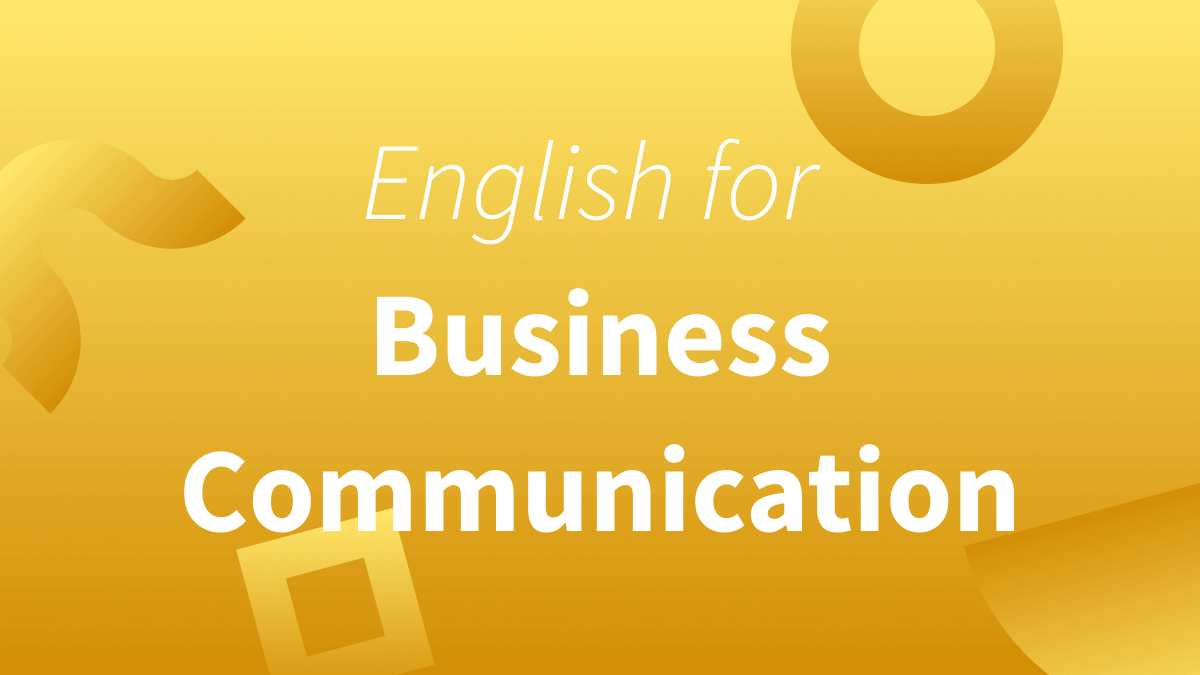English for Business: Table of Contents
Introduction: English in the Business World
English in the Business World
When you first start to learn English, you should understand the basics of grammar and expand your vocabulary by learning what words mean and how to use them correctly.
The more you learn and the more fluent you become, the easier it is to realize that there are different types of English.
What we’re trying to convey is that you develop an understanding of which words and phrases are suitable for specific situations and which are not. For example, you may feel comfortable using slang terms with your friends but not with your teacher. Conversely, there are expressions you would use when writing an email to your professor that would seem odd when talking to your peers.
Similarly, there are countless expressions that are commonly used (almost exclusively) in the business world.
To communicate clearly and confidently, you should comprehend what these phrases mean. Below, we’ve compiled a list of 25 of them to help you write more fluently and confidently at work.
But before we dive into those, let’s first go over a few tips for effective communication in the workplace.
Tips for Effective Communication
In Business English Writing: Advanced Masterclass, Marc Roche extensively covers many topics regarding English in business communication, including how to write emails, business letters, reports, and more. His book serves as the source of the summarized first three tips listed below.
1. Clarity and Simplicity Are the Keys to Good Writing
A staple of good writing is to keep things as clear and simple as possible. This holds true when writing in business settings, too. Many people think that they must use long and complex sentences to convey a sense of intelligence and professionalism, but this isn’t the case.
Being able to write about complicated topics in an easy-to-follow manner is what makes good writing, well, good!
You can ensure your writing is simple and clear by:
- Not using unnecessarily long and difficult words
- Splitting long and convoluted sentences into two (or more)
2. Clear Thinking = Effective Writing
To achieve clarity and simplicity in your writing, you must have a good understanding of what you’re writing about. In other words, if you’re uncertain about the topic, your audience will be, too.
Roche includes a seven-step tool in his book:
- Identify your core message: Before you begin writing, ask yourself, “What’s the main message I want to convey?”
- Brainstorm: Jot down everything you think is essential to mention that will help you get your point across.
- Organize your thoughts: Gather your ideas and organize them into groups.
- Create a logical flow: Determine a logical order that will most effectively present your point or main idea.
- Define your message: Now that you have identified the key points and a coherent way to present them, write a clear statement of your overall message.
- Draft your piece: Begin drafting your text as you follow the flow you developed and keep the main message in mind.
- Review and refine (more on this later): Review your first draft and make any necessary corrections and changes.
3. Use Active Voice (Most of the Time)
Using the active voice is another way to add clarity to your writing. By default, it is usually easier to understand because it tends to be less wordy than passive voice.
Active Voice: The team turned in the report well before the deadline.
Passive Voice: The report was turned in by the team well before the deadline.
However, keep in mind that this is a general guideline. There may be times when the use of passive voice is more appropriate, like when you want to emphasize the action because the subject is either unknown or insignificant.
The invoice was sent to the client yesterday.
In the sentence above, the emphasis is on the action and not on who sent the invoice.
4. Avoid Slang and Clichés
Regardless of how close you think you are to your boss and supervisors, it’s best to play it safe and avoid using slang. They may be friendly, but they will most likely always expect a level of professionalism on your part.
Sup, Mr. Patterson.
Hello, Mr. Patterson.
It’s also a good idea to avoid clichés—unoriginal and overused expressions. They lack depth, and you risk showing that you aren’t putting much effort into what you’re writing.
Let’s think outside the box.
Let’s come up with more creative, imaginative, and innovative ideas.
5. Always Proofread and Edit
You can follow all the tips and advice listed above, but if your writing is riddled with grammar, spelling, and punctuation errors, you will come off as careless and unprofessional. Check your writing, and then check it again.
Bonus Tip: LanguageTool Can Ensure Your Writing is Error-Free
Spelling, grammar, and punctuation may not be your strengths, and that’s okay. Even so, your writing should not contain any mistakes, especially in professional settings.
But how can you avoid this? By using LanguageTool—an advanced writing assistant that detects and corrects errors, so you can focus solely on the message of your text. It also helps you paraphrase sentences to make them sound more formal.
25 Business Phrases You Should Know
1. A ballpark figure
If someone is asking for a ballpark figure, they’re requesting an “estimate.”
Can you give me a ballpark figure on how much this project will cost?
2. Add value
To add value means to “contribute something beneficial.”
The entire team is sure that the new hire will add value to the company in many ways.
3. Back to the drawing board
When someone says back to the drawing board, that means it’s time “to start something from the beginning, usually because of an unsatisfactory result.”
Unfortunately, that’s not the result we were looking for. It’s back to the drawing board for us.
4. Bring to the table
This is a phrase you may hear during an interview. If you’re asked, “What do you bring to the table?” they’re asking, “What skills, resources, or ideas can you contribute?”
There’s a lot I can bring to the table, like creativity and determination to appease the clients by any means necessary.
5. Call it a day
To call it a day means “to stop working or end an activity, either temporarily or permanently.”
We’ve been working on this for hours. Let’s call it a day and try again tomorrow.
6. Circle back
To circle back means “to return to a topic or issue at a later time.”
I’m circling back to see if you’ve heard anything about the potential buyers.
7. Down the line
Down the line means “in the future or at a later point.”
We’ll figure that out down the line, but right now, it’s not our priority.
8. From the ground up
From the ground up means “to start something from the beginning.”
I’m proud to say we built this business from the ground up.
9. Going forward
Going forward is synonymous with the expression “from this point forward” or “from here on out.”
Going forward, we’ll present the profit numbers at the end of every month.
10. Go the extra mile
It’s a good thing if you hear someone say you’re going the extra mile. That means you’re “putting in extra effort and exceeding expectations.”
John is great; he always goes the extra mile to make sure the clients are satisfied.
11. Hands are tied
If your hands are tied, that means you’re “unable to help or act due to constraints or limitations.”
Unfortunately, my hands are tied right now. It’s up to the accounting department to approve the budget.
12. Keep me in the loop
To keep someone in the loop means to keep them “informed or updated about something.”
Louise asked that I keep her in the loop if there are any new developments.
13. Learning the ropes
Usually, when you first start working somewhere, you’ll have to learn the ropes, which means “to acquire knowledge or skills needed to perform a task or job.”
Don’t give David a hard time. He’s still learning the ropes.
14. Let’s crunch the numbers
To crunch the numbers means “to calculate numerical data or figures.”
Help me crunch the numbers, so I can figure out how to give everyone a generous bonus for the holidays.
15. Leverage
To leverage something means “to use resources, relationships, skills, or opportunities to gain an advantage or achieve a desired outcome.”
Let’s leverage the partnership to expand to untapped markets.
16. Micromanage
Micromanage means “to excessively control every detail of a task or project someone is completing.”
Like most, I don’t work well under supervisors who micromanage.
17. On the same page
To be on the same page means “to have a shared understanding with someone on a certain topic.”
After the meeting, the entire team was on the same page about how to proceed.
18. Streamline the process
To streamline the process means “to optimize a procedure to make it as efficient and effective as possible.”
We had to brainstorm ideas to streamline the process to avoid working overtime every week.
19. The big picture
The big picture refers to “the overall perspective of a situation or scenario.”
Although there were many concerns, we had to focus on the big picture, which was increasing brand awareness.
20. The bottom line
The bottom line means “the conclusion, most important aspect, or outcome.”
The bottom line is that we have to increase profits by the end of the quarter.
21. The eleventh hour
The eleventh hour refers to “the moment just before a deadline.”
It was a lot of hard work, but we finished the project and turned it in at the eleventh hour.
22. Touch base
To touch base means to “contact someone, usually to check progress or exchange information.”
I asked her to touch base with me if she hears anything about the marketing strategy.
23. To get someone up to speed
To get someone up to speed means “to update them with information and bring them up to the same level of knowledge or understanding as others.”
Don't worry. I’ll get you up to speed so that you’re ready for the presentation.
24. Workflow
Workflow refers to the “steps or tasks in a work process.”
I restructured my workflow and found that my productivity skyrocketed.
25. Win-win situation
A win-win situation is when “all parties involved end up with favorable outcomes.”
It was a win-win situation for everyone involved.
Write Professionally With LanguageTool
One of the most significant components of writing well in a professional setting is to avoid spelling, grammar, and punctuation mistakes. This can be achieved even if these aren’t your strong points by using LanguageTool, an advanced writing assistant that ensures your writing is error-free.
Not only does it correct your work, but it can also paraphrase your sentences to better suit your desired tone and style.
Give it a try—it’s free!

